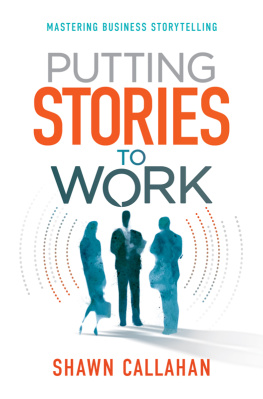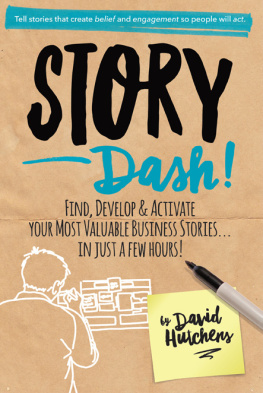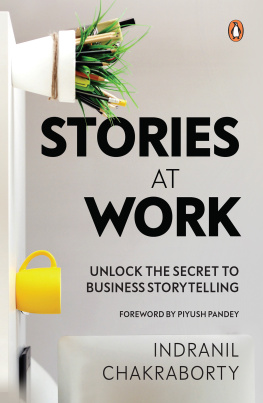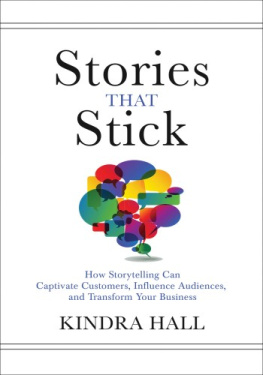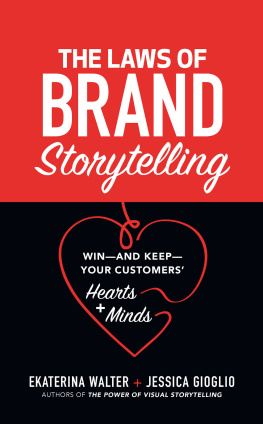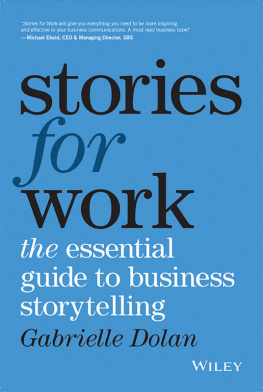Putting Stories
to Work
First published in 2016 by Pepperberg Press, an imprint of Anecdote Technology Pty Ltd, Melbourne, Australia
Shawn Callahan 2016
The moral rights of the author have been asserted.
All rights reserved. Except as permitted under the Australian Copyright Act 1968 (for example, a fair dealing for the purposes of study, research, criticism or review), no part of this book may be reproduced, stored in a retrieval system, communicated or transmitted in any form or by any means without prior written permission.
All inquiries should be made to the author.
National Library of Australia Cataloguing-in-Publication entry:
Creator: Callahan, Shawn D., author.
Title: Putting stories to work: mastering business storytelling/Shawn Callahan.
ISBN: 9780992338558 (hardback)
ISBN: 9780992338565 (paperback)
ISBN: 9780992338572 (Kindle)
ISBN: 9780992338589 (EPUB)
Subjects: Business presentationsTechnique.
Business communicationTechnique.
Oral communication.
Storytelling.
Dewey Number: 658.452
Project management by Michael Hanrahan Publishing
Cover and text design by Kerenza Smith, Designsmith Ltd
Typeset by Vanessa Battersby
10 9 8 7 6 5 4 3 2 1
Disclaimer
The material in this publication is of the nature of general comment only, and does not represent professional advice. It is not intended to provide specific guidance for particular circumstances and it should not be relied on as the basis for any decision to take action or not take action on any matter which it covers. Readers should obtain professional advice where appropriate, before making any such decision. To the maximum extent permitted by law, the author and publisher disclaim all responsibility and liability to any person, arising directly or indirectly from any person taking or not taking action based on the information in this publication.
For Sheenagh, wellspring of love and support
Contents
Introduction
I recently turned 50 and as a birthday present my younger brother Scott organised a road trip for the two of us along the coast of California. We spent the first week visiting many wineries between Napa and Santa Barbara, and sharing many stories. We then drove through LA and were just pulling into San Diego when we got onto the topic of goal setting, an activity to which Scott is dedicated. Thats when I dropped Dilbert cartoonist Scott Adams business-success bombshell, bluntly offering, Of course, you realise goals are for losers. My brother nearly fell out of the car. He couldnt believe what Id said. I had to explain that, despite Adams alarming phrasing, he was not just trying to be controversial. Rather, he was making the good point that unless you have a process for change, setting a goal is a waste of time.
After calming my brother down, I got to thinking about all the books Ive read on business storytelling. They all explain why storytelling is important. Many describe the types of stories you might tell. Some explain the characteristics of good stories and suggest ways to find them. A few even offer you stories to learn and share. Yet none really give you a process with which to build your business storytelling skills. Thats my aim in this book.
There are many good business storytellers out there, such as Howard Schultz (chairman and CEO of Starbucks), Indra Nooyi (chairperson and CEO of PepsiCo) and Richard Branson (founder of Virgin Group), just to name a few. But outstanding business storytelling mostly takes place during unrecorded company off-sites, team meetings and informal catch-ups. Ive always wondered how these leaders learned their storytelling skills. Was it because of their family culture, where they were immersed in storytelling from a young age, or did they pick it up from other leaders theyve admired? Perhaps it was just the self-realisation that when they shared an experience, people tended to remember the point they were making. Steve Denning was spot-on when he called his seminal business storytelling book The Secret Language of Leadership because the leaders who inspire and engage using stories rarely share their secret. They see it as a differentiator.
The vast majority of business leaders are not business storytellers. Sure, they share stories when they get together with family and friends. We all do. Storytelling is a very human condition. But when communicating in business, most leaders rely solely on reasoning, argument and logic to get their message across and to try and inspire action. If they have given storytelling any thought at all, they are usually of the misguided view that sharing a real-life experience is a waste of timeits not business-like. (We will show in Chapter 1 why thats untrue.) The majority of business leaders, however, havent even considered the power of storytelling. They havent realised why some of their peers are engaging communicators and others are not.
The leaders who do tell stories have developed a process for improving their storytelling and finding good stories to tell whether they know it or not. Its a process that will have evolved naturally over time. Yet leaders today who must engage and inspire their people dont have the time to take such an ad-hoc approach, hoping to stumble across an effective way of learning business storytelling skills. They need an explicit, streamlined approach to business storytelling. In my work with Anecdote, I have helped develop such a process.
* * *
I wandered into business storytelling in the late 1990s. At the time I was working in IBMs Canberra office, helping clients manage their knowledge, especially the things people knew but couldnt set down in words; for example, knowing when to move from the design phase to the build phase, or knowing how to close a large and complex sale, or knowing where to find the next productive oil well. To prepare for this job, when I arrived at Big Blue, one of the first things I did was map out who were the experts in the field of knowledge management inside the companyno small task, as at that point IBM had over 300,000 employees, spread across just about every country on the planet. During my search I heard about Dave Snowden, who was based in the United Kingdom. He was involved in IBMs recently founded Institute for Knowledge Management and I was told he was an entertaining speaker. So I sent him an email asking whether he had any videos of himself talking about knowledge management that I could share with my customers. He said he could do better than that and explained that he would soon be coming to Australia: Why dont you set up a seminar and Ill come and present our latest thinking. I thought that sounded great, so I invited 100 or so customers to a function room in Old Parliament House to hear the talk.
Dave flew into Canberra just in time for the seminar; I picked him up from the airport and drove him straight to the venue. He was still wearing his tracky daks, but he told me he had a special travelling suit in his case that never needed ironing and he slipped into this at the back of the room. When I asked Dave whether hed like me to set up his computer, he looked at me as if I was mad and just asked for a whiteboard. I thought to myself: This is a day-long presentation. How is he going to keep people engaged?
When all of my guests had settled in and Dave started speaking, his method quickly became clear to me. He would tell a story, usually about something that had happened to him, and then he would use that story to make a point related to the field of knowledge management.

